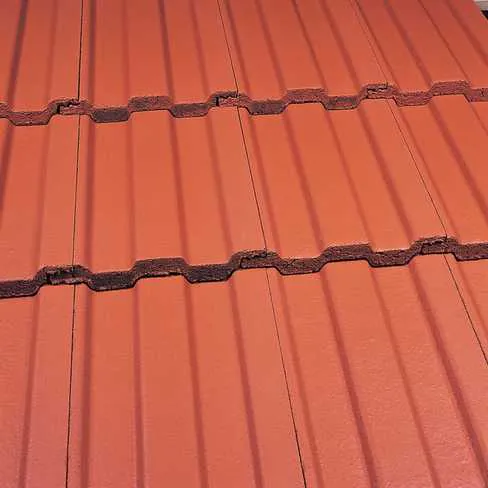Interlocking roof tiles have become increasingly popular in recent years due to their durability, ease of installation and ability to provide a unique aesthetic to homes and buildings.
If you’re considering interlocking roof tiles for your upcoming roofing project, there are a few things to keep in mind to ensure that you select the right type of tile for your needs.
What are they exactly?
That’s what we’re here to find out.
At Good Build Superstore, we’ve put together the ultimate buyer’s guide to interlocking roof tiles.
Let’s dive right in.
Table of contents:
- What are the benefits of interlocking roof tiles?
- What factors do I need to consider when choosing interlocking roof tiles?
- Wrapping it up
What are the benefits of interlocking roof tiles?

Interlocking roof tiles are designed to interlock with one another, creating a secure and weather-tight roof system. There are several benefits to using interlocking roof tiles, including:
Durability
Interlocking roof tiles are made from durable materials, such as concrete or clay, which are designed to withstand harsh weather conditions and last for many years. This makes them a good investment for homeowners who want a long-lasting roofing solution.
Weather resistance
The interlocking design of these roof tiles creates a weather-tight seal that helps to prevent water from penetrating the roof. This makes them ideal for areas with heavy rain.
Energy efficiency
Interlocking roof tiles can help to improve the energy efficiency of your home by reducing the amount of heat that escapes through the roof. This can help to lower heating costs in the winter and cooling costs in the summer.
Aesthetics
Interlocking roof tiles are available in a variety of colours and styles. So, you’ll have no trouble choosing a roof that complements the overall look of your home. This can help to improve the aesthetic appeal of your home and increase its resale value down the road.
Low maintenance
Interlocking roof tiles are relatively easy to maintain, as they are designed to resist mould, mildew and algae growth. This means that you won’t need to spend a lot of time or money on roof maintenance and cleaning. And who doesn’t like that!
What factors do I need to consider when choosing interlocking roof tiles?

Now that you’re fully aware of the many advantages of interlocking roof tiles, let’s take a close look at how you should go about choosing the right ones for your roof.
Material
Interlocking roof tiles can be made from a variety of materials, including clay, concrete and synthetic materials such as plastic or rubber. Each material has its own unique characteristics and advantages, so it’s important to select the material that best suits your needs.
Check this out:
Clay tiles are known for their durability and natural beauty, and they can be a good choice for homeowners who want a traditional look. Concrete tiles are also durable and come in a variety of colours and styles. Synthetic tiles are lightweight, affordable, and easy to install, making them a popular choice for DIY projects.
Style
Interlocking roof tiles come in a wide range of styles, from traditional to modern. Some of the most popular styles include Spanish, slate and wood shake.
Here’s the scoop:
Spanish-style tiles are typically made of clay and are known for their curved shape and bright colours. Slate-style tiles are designed to look like natural slate and come in a variety of colours. Finally, wood shake-style tiles are made to look like natural wood and are a popular choice for homeowners who want a rustic look.
Colour
Let’s face it:
The colour of your interlocking roof tiles can have a big impact on the overall look of your home. Most manufacturers offer a wide range of colours to choose from, so you can select the one that best complements your home’s exterior.
When selecting a colour, it’s important to consider the climate in your area. Lighter colours can help to reflect heat and keep your home cooler in warmer climates, while darker colours can help to absorb heat and keep your home warmer in cooler climates.

Cost
The cost of interlocking roof tiles can vary significantly depending on the material, style and manufacturer.
The thing is:
Clay tiles are typically the most expensive, while synthetic tiles are often the most affordable. So, don’t forget to consider your budget when selecting interlocking roof tiles.
That being said:
It’s also important to remember that investing in quality tiles can save you money in the long run by reducing the need for repairs and replacements.
Installation
Interlocking roof tiles are designed to be easy to install, but the installation process can vary depending on the type of tile you choose. Some types of tiles require special tools or techniques for installation, while others can be installed using basic tools and techniques.
If you’re planning to install the tiles yourself, it’s a good idea to select a type that’s easy to install and comes with clear instructions.
Maintenance
Interlocking roof tiles require minimal maintenance so long as you follow the manufacturer’s recommendations closely to ensure that your tiles last as long as possible. Most manufacturers recommend cleaning the tiles periodically with a mild detergent and water to remove any dirt or debris.
What’s more:
It’s a good idea to inspect the tiles periodically for signs of damage, such as cracks or chips. If you notice any damage, have it repaired as soon as possible to prevent further damage to the tiles or your roof.
Wrapping it up

Interlocking roof tiles can be a great choice for homeowners who want a durable, easy-to-install roofing solution that provides a unique aesthetic to their home or building.
When selecting interlocking roof tiles, make sure you take into account factors such as material, style, colour, cost, installation and maintenance to ensure that you select the right type of tile for your needs.
Keep our guide handy, and you’ve got this!
